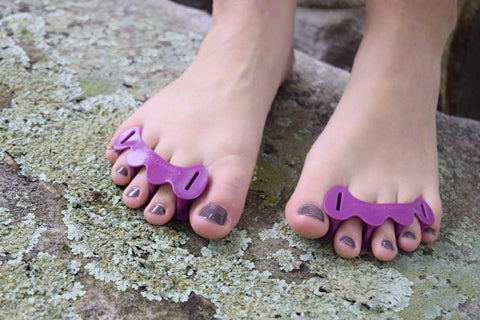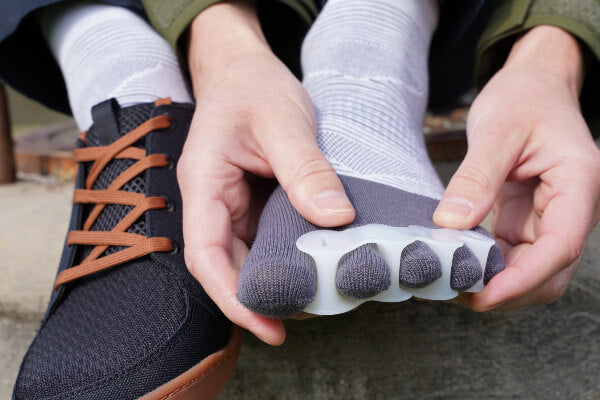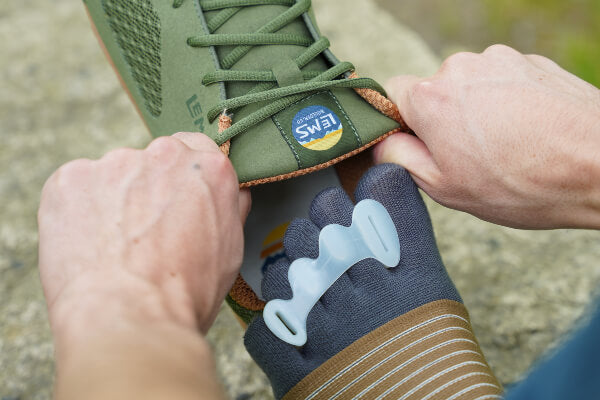Sesamoiditis: Conventional vs. Natural Approaches

In this video, Dr. Ray McClanahan, a sports podiatrist at Northwest Foot and Ankle and the inventor of Correct Toes, discusses the common and painful condition known... Read more

Sesamoiditis: Irritation of the sesamoid bones.
Irritation, imbalance, or fracture of two small bones—sesamoids—near the big toe is a forefoot problem that may cause pain in some individuals. These two sesamoid bones, located on the underside of the foot, directly below the first metatarsal bone—the long, thin bone that’s positioned between the ankle bones and the big toe—are approximately the size of corn kernels and act like pulleys. The sesamoid bones function like a kneecap (another type of sesamoid bone) for the big toe joint.
The sesamoid bones provide a smooth surface over which the toe flexor tendons slide, and they improve the ability of these tendons to transfer force from the lower leg muscles to the proximal phalynx, or bone, of the big toe. The sesamoid bones under the base of the big toe also help bear some of the bodyweight, reducing the stress on other forefoot structures. Sesamoid bones, like other bones in the body, can break, and the tendons that pass over these structures can cause soft tissue irritation and inflammation. Sesamoiditis is most commonly seen in runners, baseball catchers, and ballet dancers.
Special grooves on the bottom of the first metatarsal bone accommodate the sesamoid bones. The sesamoid bones may move out of their special grooves and begin wearing away cartilage and bone in individuals with flat feet, flexible feet, or bunions, or if the feet have undergone some of the other anatomical changes that can result from long-term conventional footwear use. Feet that are imbalanced or too flexible may place excessive pressure on the sesamoid bones and cause them to fracture.
Sesamoiditis may cause a person to limp or walk on the outside aspect of his or her foot to help remove pressure from the painful area. Gait changes are a problematic compensation for this health problem, as they may cause pain and disability in one of the other lower extremity joints, such as the knee or hip.
Sesamoiditis usually involves a dull pain under the big toe joint that fails to resolve over time. Sesamoiditis-related pain is usually intermittent and may be worse when wearing certain shoes or participating in certain activities.
Some of the most common signs and symptoms associated with sesamoiditis include:
Sesamoiditis is an overuse injury that involves chronic, or long-term, inflammation of the sesamoid bones and the tendons that act on these bones. In some cases, a sudden and excessive upward bending force on the big toe may cause sesamoiditis. Wearing high heels and experiencing certain types of foot trauma may also lead to sesamoiditis.
Conventional footwear plays a prominent role in aggravating the sesamoids and their surrounding structures. Shoes with tapering toe boxes and toe spring can cause the sesamoids to become dislocated, causing dysfunction (click here for a video demonstration of this phenomenon). When the hallux, or big toe, is properly aligned with the first metatarsal bone, the sesamoids are also properly aligned in their grooves and function as nature intended.
Injured or inflamed sesamoid bones can take a long time to heal, as they bear almost continuous pressure with standing or walking. Conservative care methods that may be helpful in resolving sesamoiditis include:
Anti-inflammatory medication, cortisone injections, and certain types of surgery are more aggressive approaches for treating sesamoiditis, though they may be necessary in some individuals. A foot care professional may recommend surgery, including sesamoid bone removal, if conservative care measures fail to resolve this health problem.
Disclaimer:
The above content is for educational or informational purposes only and is not intended to replace or augment professional medical instruction, diagnosis, or treatment. Read full disclaimer here.$65.00
$10.00
$14.00
$70.00
$30.00
$35.00

In this video, Dr. Ray McClanahan, a sports podiatrist at Northwest Foot and Ankle and the inventor of Correct Toes, discusses the common and painful condition known... Read more

In the world of healthcare, there are no panaceas, or cure-alls. But a few simple strategies can have... Read more


Hi,
I am battling sesamoid pain following an Austin bunionectomy with screw fixation. The bunion was corrected, which I am very thankful for; however, I have been left with agonizing pain under the ball of my foot (it feels like a pebble).
My questions: Even though the bunion was removed (and the big toe is aligned), is it possible that the toe could still be “off,” resulting in the sesamoid bones becoming slightly misaligned and causing this pain? Also, will Correct Toes help in aligning the sesamoid bones in their proper location? I am an active individual who loves running and exercising, and this pain is debilitating. Thank you for your time!
Hi, Candy,
Thank you for your comment. I’m sorry to hear about that sesamoid pain. That does indeed sound agonizing.
It’s hard to say exactly what’s going on here without the benefit of a full health history interview and physical examination, so I can’t really comment on possible underlying problems that may or may not be due to the bunionectomy.
What I can say is that misaligned sesamoid bones can be a significant source of pain at the base of the big toe, and that Correct Toes toe spacers have, in our experience, been helpful in realigning the sesamoid bones and alleviating sesamoid-related discomfort.
Please do let us know if you have any additional questions!
Kind regards,
Marty Hughes, DC
Hello. My daughter has been diagnosed with a sesamoid stress fracture on her left foot, with necrosis of the sesamoid. The doctor says she will need to have a sesamoidectomy. Do you know if physical therapy will help once there is already necrosis in place? Trying to avoid surgery here, but I don’t want there to be further damage if she already has necrosis. Thank you so much.
Hi, Mercedes,
Thank you for your message. I’m so sorry to hear about your daughter’s diagnosis. I can certainly understand why you’d want to avoid surgery for this issue, as it typically has poor outcomes and often results in big toe dysfunction. There are a number of alternatives you might consider/look into before consenting to the sesamoidectomy, including shockwave therapy, bone growth stimulator therapy, and regenerative injection therapies. It would be helpful to know what imaging study was performed to render the diagnosis of necrosis. I also wonder if your daughter has undergone a period of immobilization to see if the problem will heal naturally? And, finally, does your daughter still wear shoes that possess heel elevation and toe spring? If so, this kind of footwear is putting pressure and tension directly onto her vulnerable sesamoids and is best avoided.
Please do let us know if there is anything else we can do to assist or if you have any follow-up questions for us.
Kind regards,
Robyn Hughes, ND
Hi. Can you suggest what shoes/trainers to wear for a sesamoid fracture as well as problems associated with wide feet? Thank you.
Greetings, Michelle,
Thank you for your comment. For a sesamoid fracture and wide feet, it’s important to choose footwear that offers some degree of cushioning while not restricting toe splay. Look for wide toe box shoes with a moderate level of cushioning that allow your feet to move naturally without adding stress to the sesamoids. Certain models of Altra, Lems, or Topo Athletic footwear could be a good choice, as they have a roomy toe box that can accommodate Correct Toes—an important tool in restoring optimal sesamoid bone orientation—and a comfortable footbed. My best recommendation, though, is to consult a foot care provider who can assess your specific needs and provide personalized recommendations.
Kind regards,
Robyn Hughes, ND